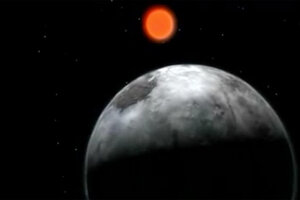15-year-old discovers planet. Why do children make such great astronomers?
Seventeen-year-old Tom Wagg of England discovered a new planet when he was just 15 years old. Studies show that children are more curious than adults. Could that make them better astronomers?

Tom Wagg discovered a planet when he was just 15 years old. The teen was working as an intern at Keele University in England when he found a tiny fluctuation in the light of a star as the planet passed in front of it, according to a statement released by the university.
Tom made the discovery while working with the university's Wide Angle Search for Planets (WASP) program, which searches for extrasolar planets. The new planet is 1,000 light years away in our galaxy, in the Southern constellation of Hydra.
Because the new planet is the 142nd discovery by the WASP collaboration, it has been given the catalog number WASP-142b. It is roughly the size of Jupiter, the largest planet in our solar system, and orbits tightly around its star, according to the university statement.
While Tom's age and inexperience may make the discovery seem like a lucky strike, there's evidence that his observation could have been helped by his age.
Kids are observant. They ask questions, they notice the details, and they approach new material without assumptions.
Children are more curious than adults, says Dr. Joon Yun in his published collection of essays titled "Hiding in Plain Sight."
"Children are naturally driven by curiosity and the need to experience – through seeing, touching, tasting, feeling and hearing – the external world. A child's mind is poised to learn about the world, as it exists, rather than the world as he expects it to be.... Children often notice details more literally and accurately than adults."
Parents agree that children are especially detail-oriented. In a Huffington Post blog, a mother talks about "life with her observant child." She writes that her daughter "recognizes patterns, notices changes. Asks about everyone."
In 2013, the Telegraph reported on a study done by Littlewoods.com. According to the study, four-year-old girls ask 390 questions per day, averaging one question every one minute and 56 seconds of a parent's waking day.
Tom's discovery seems less far-fetched with this data.
And, there are other children who have made similar astronomical discoveries.
In 2011, a 10-year-old Canadian girl named Kathryn discovered a supernova when she and her father, an amateur astronomer, were clicking through images of starfields in search of subtle differences between frames.
Her father described the discovery to the Toronto Star.
“Kathryn pointed to the screen and said: ‘Is this one?’ I said yup, that looks pretty good.”
But it's important to mention that Tom did have a considerable amount of experience and knowledge backing his discovery. According to CNN, he has a special interest in extrasolar planets, or planets that exist around star other than the sun.
"Tom is keen to learn about science, so it was easy to train him to look for planets',' said Professor Coel Hellier, who leads the WASP project at the university.
And yet, Tom represents a wide spectrum of children across the world who are using their curiosity to further science.
"I'm hugely excited to have a found a new planet, and I'm very impressed that we can find them so far away," said Tom.

